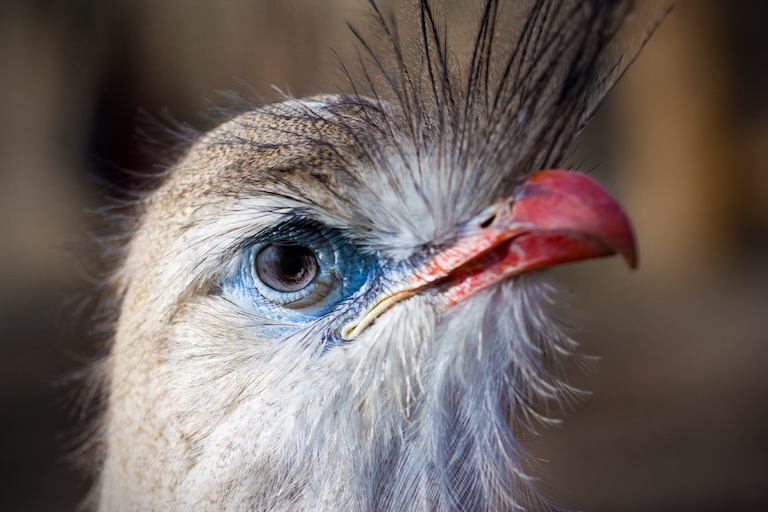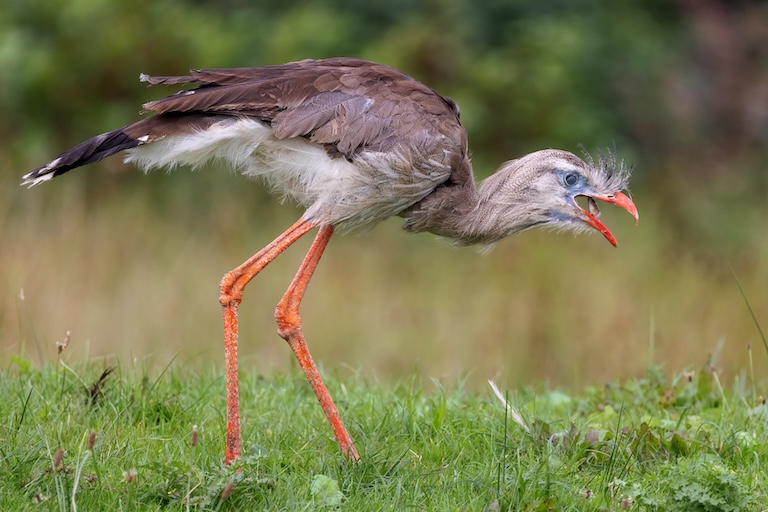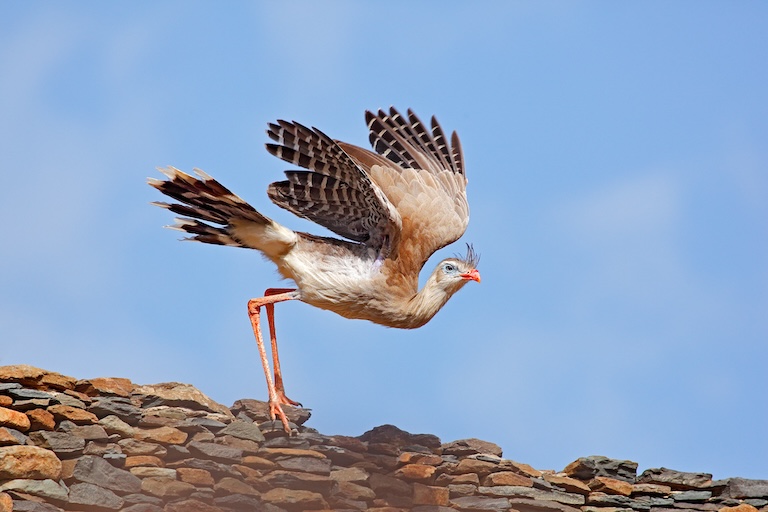Red-legged Seriema Profile
About 110 million years ago, South America decided it didn’t like this whole supercontinent setup and broke off from Gondwana, leaving Africa behind.
Quite a while later, it Brexited from Antarctica and spent around 30 million years “finding itself” as an island continent before cosying up to Mexico and letting all sorts of immigrants in to spoil everything.
But during its alone time, this enormous landmass created some of the most incredible prehistorical vertebrates we know of.
Giant, 4-tonne sloths, a 16-metre caiman called Purussaurus with a bite force higher than a T-rex and an entire family of terrifying giant birds who had apparently refused to accept the dinosaur extinction and were carrying on as normal.
These were the terror birds, and their story, while something fierce, is one for another time. Suffice it to say, they’re all dead now. But their closest relatives still exist, in a group of large, ferocious running birds known as the Seriemas.
Thankfully, unlike the terror birds, the red-legged Seriema is far from extinct, and as far as smaller, contemporary versions of prehistoric monsters go, they’re carrying the torch quite well.

Red-legged Seriema Facts Overview
| Habitat: | Thorny scrub and semi-arid woodland regions, savannas and ranchlands; hilly grasslands near wooded areas |
| Location: | Argentina; Bolivia, Plurinational States of; Brazil; Paraguay |
| Lifespan: | Unknown |
| Size: | 75 to 90 cm (30 to 35 in) long |
| Weight: | 1.5 to 2.2 kilograms (3.3 to 4.9 lb) |
| Colour: | greyish-brown, with fine bars; red beak, yellow eyes |
| Diet: | Lizards, snakes, insects, small mammals; also grains, fruits, tree gum |
| Predators: | |
| Top Speed: | 25 km/h (15 mph) on foot. Faster in flight |
| No. of Species: | 1 |
| Conservation Status: | Least Concern |
The Red-legged Seriema is possibly the closest living relative of the infamous Phorusrhacids – the Terror Birds.
Despite being significantly smaller than the largest of their extinct cousins (there were small terror birds, too!), they are formidable animals, choosing to both hunt and flee on foot as much as possible, though they are capable of flying too.
These remnants from a much more diverse, unique community of prehistoric animals maintain some of the scary, ancient stuff you’d expect from the Lost World.
They shriek, they slam their prey and they tear their own babies to pieces.
Interesting Red-legged Seriema Facts
1. They’re relics
Along with their sister species, the black-legged seriema, these birds make up the entirety of the tiny family of Cariamidae; the only family left in the ancient order of Cariamiformes.
This order once contained four other families of birds, including the well-known Terror Birds, as well as their North American and European cousins. They were once placed in the crane clade of birds, but have recently been reassigned to sit with parrots, Falcons and Songbirds.
As the only remaining members of their entire order, they have held the line where all others have failed!

2. They’re territorial
One reason for their continued existence may relate to how tough they are.
Being smaller helps, too, since there’s more to eat and fewer invasive humans consider them food, but these are still some of the largest ground-dwelling birds in the Neotropics.
And seriemas play their part by being aggressively territorial and protective of their space. Territorialism is mainly directed at conspecifics, but captive animals have displayed it towards humans and their own reflections, too.
One key element to the seriemas’ defence is its call. 1
3. They’re loud
These diurnal hunters start singing before dawn and continue until even after dark, though the majority of calls are heard in the early morning.
They have an introduction, a middle and a conclusion to their call, though some just stop with the intro, especially when busy foraging.
Singing can last over a minute and often involves multiple birds. When one starts, another may listen closely for a while before joining in, either in time or out of phase with one another, but tying their calls together into a long session.
Calls are combined with some funky moves: the loudest part of the song is belted with the neck bent so far back that the head of the bird is almost resting on its back. And this is a loud call – it can be heard from several kilometres away! 2

4. They’re good guard animals
Having described the ruckus, it should be no surprise that these noisy birds make a good early warning system for farmers.
They’re not big enough to take on a chicken, so can be kept comfortably alongside the most common livestock and all hell will break loose if a predator or cow tipper enters the scene.
And this is exactly how some farmers use them, having tamed the birds to work as guard animals.
5. They’re brutal
Seriemas eat snakes, lizards and small rodents, as well as grains and fruit, but it’s the former group that showcases the bird’s terrifying nature.
Prey slamming is common, and involves a Seriema picking up a victim and throwing it as hard as possible onto a rock to smash it to pieces.
With a bird this size, the victim is usually a lizard or similar, but it does pique the imagination and make you wonder if its cousins would once do that to one of the small horse species of the times. 3
6. They are infanticidal
Their brutality doesn’t stop at lizards, either. Many birds are known for being pretty ruthless in their parenting – often starving the weaker chick in favour of putting all their resources into the larger one – but seriemas take it to the next level.
One research team documented a “20-minute video of an adult killing one of three nestlings, eating part of it, and allowing the other two nestlings to feed on the carcass”.
This is something that had been witnessed in captive seriemas but until 2018 had not been seen in the wild, and shows that it’s not just a product of captivity making these birds so metal, it is just how they are.
It’s postulated that in clutches of three eggs, there’s almost always a sacrificial bird to help plump up the other two. 4
7. They can fly
All of this terrifying behaviour happens on foot, and this is clearly where the seriemas excel, but they are capable of flying when they have to.
They will flee a threat by running and will hit speeds of 25 km/h before they decide to lift off and use their wings.
This is faster than any farmer can travel on foot, though some do poison or shoot the birds for stealing crops. Regardless, both species of seriema have stable populations and are still of least concern.

Red-legged Seriema Fact-File Summary
Scientific Classification
| Kingdom: | Animalia |
| Phylum: | Chordata |
| Class: | Aves |
| Order: | Cariamiformes |
| Family: | Cariamidae |
| Genus: | Cariama |
| Species: | cristata |
Fact Sources & References
- Aline N. Silva (2016), “Behavioral repertoire of the poorly known Red-legged Seriema, Cariama cristata (Cariamiformes: Cariamidae)”, Sci Hub.
- “Red-legged Seriema”, xeno canto.
- WitmerLab (2019), “Red-legged seriema prey-thrashing behavior”, YouTube.
- Miguel Marini (2021), “Cannibalism by Cariama cristata”, Mendeley Data.
